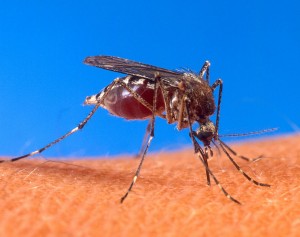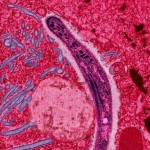 Seldom has something so tiny and so unprepossessing exacted such an immense toll of human misery. Plasmodium falciparum, the protozoa that causes the most serious form of malaria, looks like a little red comma or pear-shaped stain on the surface of a red blood cell. Yet make no mistake, this tiny protozoa is a deft killer. In the list of the world’s deadliest infectious diseases, malaria currently ranks fifth, and each year between 1 to 2.7 million people–mainly pregnant women and children–perish of the scourge.
Seldom has something so tiny and so unprepossessing exacted such an immense toll of human misery. Plasmodium falciparum, the protozoa that causes the most serious form of malaria, looks like a little red comma or pear-shaped stain on the surface of a red blood cell. Yet make no mistake, this tiny protozoa is a deft killer. In the list of the world’s deadliest infectious diseases, malaria currently ranks fifth, and each year between 1 to 2.7 million people–mainly pregnant women and children–perish of the scourge.
Epidemiologists studying this nasty disease have long searched for its origins, since this data could offer clues for battling P. falciparum. Many researchers have looked to sub-Saharan Africa, suggesting the disease first emerged there some 6000 years ago when early farmers began clearing forests and creating lots of small sunlit basins of stagnant water–breeding grounds for mosquitoes carrying P. falciparum. The large villages of the time, moreover, were thought to have offered a plentiful supply of new hosts for the parasite. Human beings are the only reservoirs for malaria.
But archaeologists have never been keen on this theory: there’s little evidence of agriculture in Africa 6000 years ago. Now a very cool new study in Current Biology by Kazuyuki Tanabe, a biologist at the Osaka Institute of Technology in Japan, and his colleagues, sheds important new light on the matter. It turns out archaeologists were right to be skeptical. Malaria emerged at least 60,000 years ago in Africa, and accompanied modern humans on their momentous journey out of Africa.
 Tanabe and his associates discovered this by analyzing 519 P. falciparum isolates from around the world–the largest collection of malaria parasites ever assembled–and sequenced two key genes. What they discovered is that the farther away the parasites were from sub-Saharan Africa, the less genetic diversity they displayed. This is precisely the same pattern that geneticists have found in the DNA of modern humans. Indigenous Africans possess the greatest genetic diversity; more remote populations such as Native Americans possess far less.
Tanabe and his associates discovered this by analyzing 519 P. falciparum isolates from around the world–the largest collection of malaria parasites ever assembled–and sequenced two key genes. What they discovered is that the farther away the parasites were from sub-Saharan Africa, the less genetic diversity they displayed. This is precisely the same pattern that geneticists have found in the DNA of modern humans. Indigenous Africans possess the greatest genetic diversity; more remote populations such as Native Americans possess far less.
The new research, says team member Francois Balloux, an epidemiologist at Imperial College London, shows that malaria and modern humans “have a shared geographic origin, age and route of spread around the world.”
This is a key piece of info for epidemiologists who need to understand the parasite’s evolving genetic diversity in order to develop a truly effective vaccine. But the study is also immensely interesting for archaeology. What environmental circumstances or human event triggered the emergence of malaria more than 60,000 years ago in Africa? And how could small nomadic bands of modern humans supply enough new hosts for the deadly parasite?
All good questions, of course. But for the moment I am riveted by the thought that our ancestors’ greatest adventure, the colonizing of the planet, began with someone feverish with malaria.
Upper Photo: Stegomyia aegypti (formerly Aedes aegypti) mosquito biting a human. Photo by United States Department of Agriculture.
Lower Photo: Plasmodium sp. sporozoite migrating through t he cytoplasm of midgut epithelia. Image by Ute Frevert; false color by Margaret Shear.